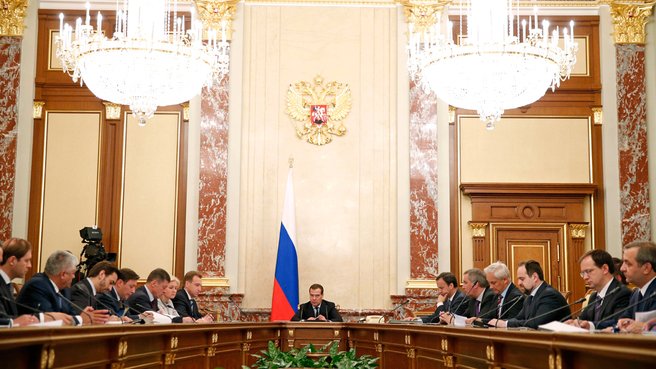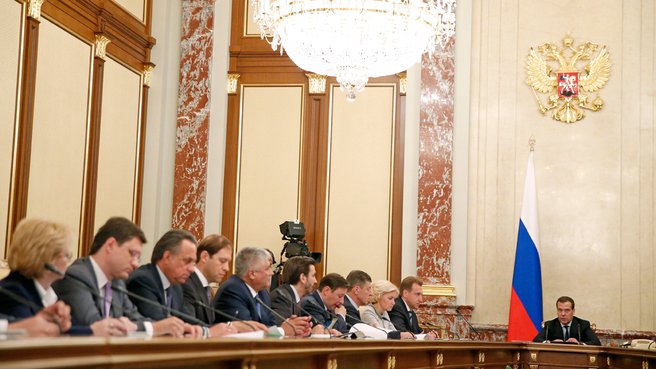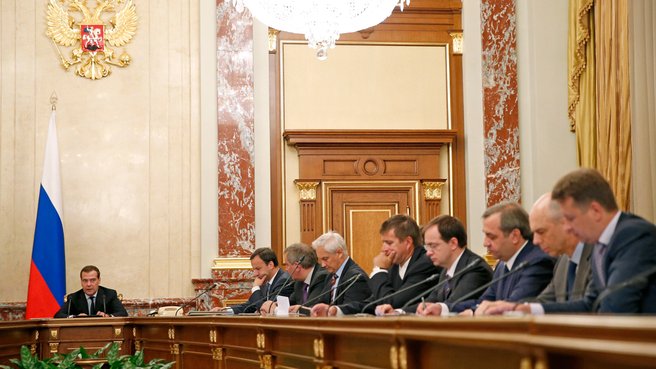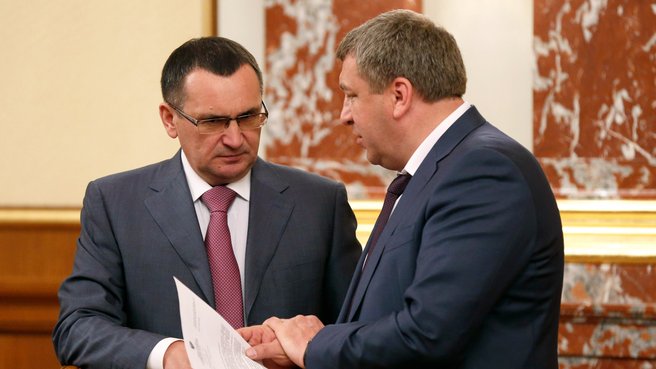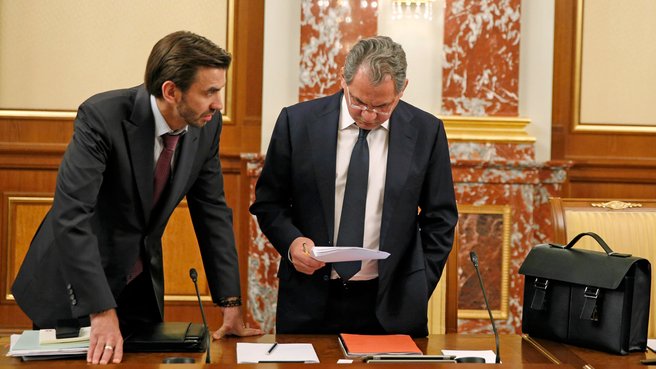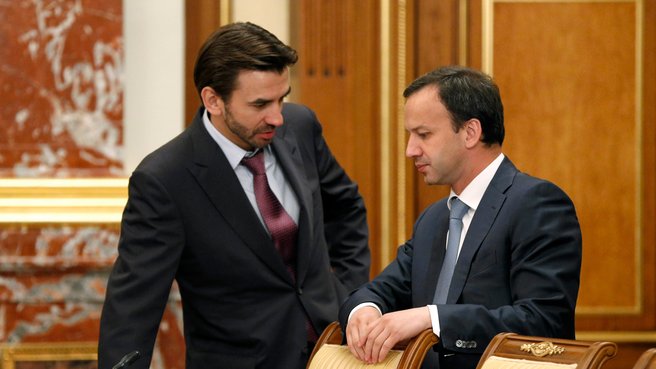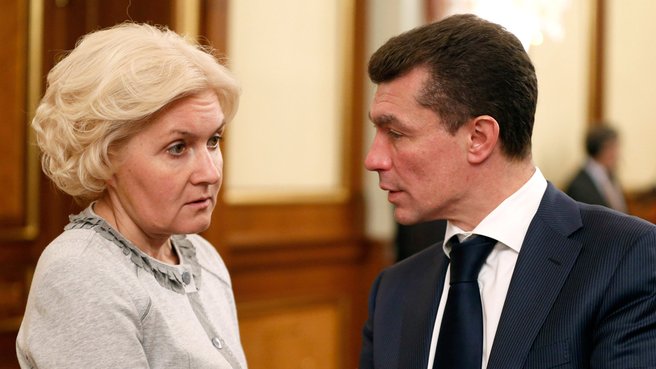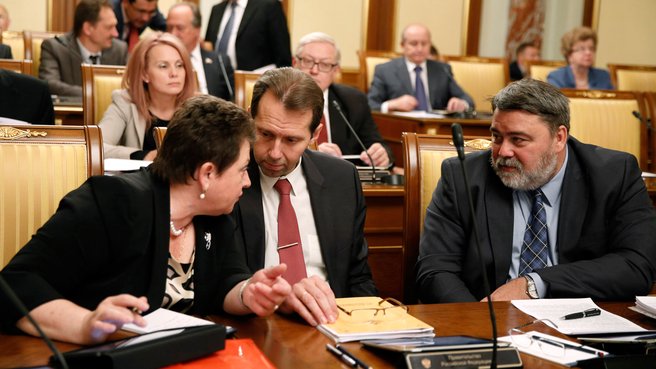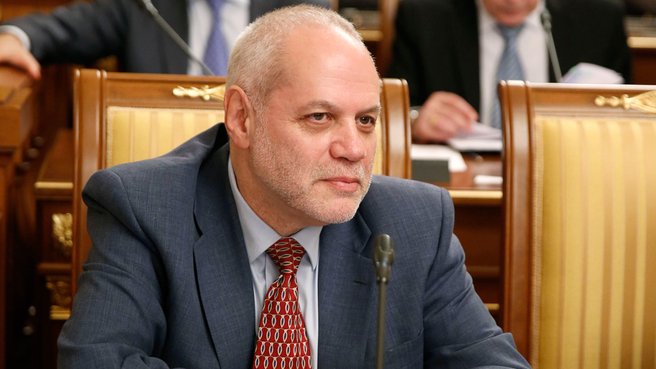The draft strategy for the development of the children’s goods industry to 2020 and an action plan to implement the strategy; nine more issues
Transcript:
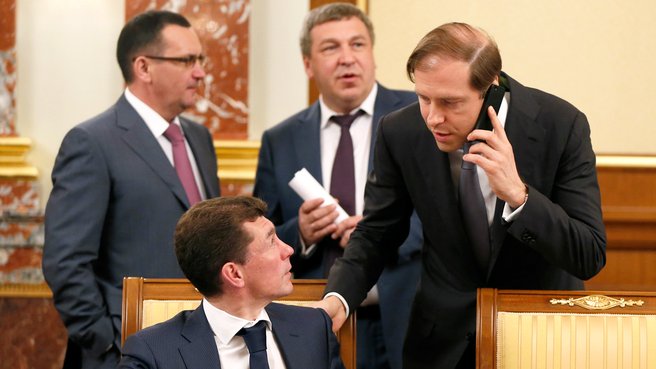
Minister of Labour and Social Security Maxim Topilin, Minister of Industry and Trade Denis Manturov, Minister of Agriculture Nikolai Fyodorov and Minister of Regional Development Igor Slunyayev
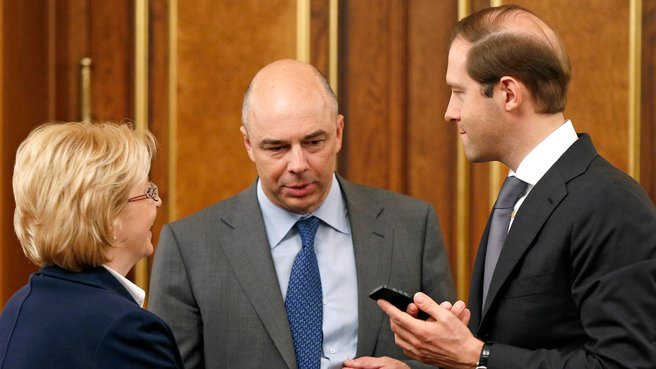
Minister of Healthcare Veronika Skvortsova, Finance Minister Anton Siluanov and Minister of Industry and Trade Denis Manturov
Government meeting
Dmitry Medvedev: Good afternoon, colleagues. Let us start with an issue that may not be as pressing as many others, but is nevertheless very important: the strategy for the development of the children’s goods industry to 2020 and the priority measures for its implementation. I’d like to remind you that the strategy is part of the National Children’s Strategy, which was debated and discussed last year.
I don’t need to tell you why this strategy was adopted. It is obvious that children’s development and ultimately the future of each family and the country as a whole depend on the conditions in which our children grow up, the toys with which they play and the books they read. Therefore, the quality of children’s goods, including toys, textbooks, cartoons and computer games influence the development of society.
It is a fact that consumers demand more from toys and children’s goods and people are no longer satisfied with what was acceptable 30 or 40 years ago. Toddlers can now use various electric appliances, including computers. Life is changing, and so companies that produce children’s goods must adjust to modern demands and produce quality goods that will be environmentally safe and have other safety attributes. There are some goods that we should produce at home rather than let foreign companies manufacture them.
There are some reliable brands of children’s goods in the Russian market, but there aren’t enough of them. I have looked up statistics and can tell you that the Russian market of children’s goods is quite substantial, around 700 billion roubles, but Russian-made goods make up only 20%. Overall, more than 300,000 people are employed in the Russian children’s goods industry. The issue concerns 15 types of activity, including manufacturing, culture, education and healthcare.
The Government must focus on this issue. We must continue prompting the children’s goods industry, from clothes and foods to books and textbooks.
The Minister of Industry and Trade will report on the draft strategy in detail. The Ministry drafted it, and I hope it will also oversee its implementation, including the development of a government policy and legislation on the children’s goods industry.
I will point out a few problems before the Minister delivers his report. It's clear that the main goal is to overcome the industry’s technological backwardness. Funds allocated for the state programme for developing the industry and enhancing its competitiveness and other state programmes should be used for this purpose. The state should support small and medium-sized business, think about taxation of producers of goods for children and enhance their protection against unfair competition and counterfeit products.
Let’s talk about these and other problems. By tradition, our regional colleagues are present at the meeting. We have invited Svetlana Orlova, Acting Governor of the Vladimir Region and member of the Government Expert Council Yevgeny Bunimovich.
Today we’ll also discuss a draft law On Accreditation in the National Accreditation System. It is aimed at improving the mechanisms of state regulation and control over the performance of the bodies that are responsible for the conformity of products to the established requirements. The Federal Accreditation Service was set up in 2011 under the President’s executive order. This new federal executive body is under the jurisdiction of the Ministry of Economic Development.
The task is to create a regulatory environment that will promote confidence in Russian products both at home and abroad. It is also important to reliably block the entry of low quality and counterfeit goods. I have just spoken about this when talking about the Development Strategy for the Children's Products Industry. The national accreditation system should not be self-sufficient and completely independent. It should be tailored to international standards and requirements. Otherwise our products won’t be appreciated in the world, and this will affect our competitive ability in the European Union and the Customs Union, where we have our closest partners.
I’d like to speak about one more issue that is directly related to the implementation of the state defence order and relevant legislation. The Government is keeping an eye on this issue. The law on the state defence order was adopted last year. It established legal foundations for regulating relations in this sphere and determined the principles of price formation. Today we’ll review a draft federal law on amendments to the Code of Administrative Offences in the context of our previous discussion. I’m referring to personal responsibility of state contractors, providers and government officials whose action or inaction have caused various violations in the placement and implementation of a state defence order. The draft suggests the following administrative fees: from 20,000 to 50,000 roubles for officials and from 300,000-500,000 to one million for companies. Under the draft an official will be disqualified for a repeated violation of these procedures.
And one more question on this subject. I would like once again to draw the attention of those who are in charge of this sphere, including Dmitry Rogozin and Sergei Shoigu, to the fact that these relations should be based not only on administrative, but also on economic accountability, meaning civil liability of unscrupulous suppliers of substandard products. It’s not enough to fine just the executives; sanctions should be applied to the entire company as well, the way it’s done all over the world. Thus, all employees should be responsible for poor performance, and they should pay damages and compensate for losses. We have repeatedly talked about this. I hope that this draft law, along with other measures, will be a major disciplinary factor.
Mr Manturov, please go ahead with the first issue.
Denis Manturov: Mr Medvedev, colleagues, in accordance with the presidential executive order and the Government resolution, we have put together a Development Strategy for the Children's Products Industry to 2020. All concerned departments were involved in drafting it. The expert analysis was conducted by experts from 40 Russian regions and over 50 public expert organisations. The strategy was approved by our Ministry’s public board.
Our work was based on the 2012-2017 National Strategy for Action for Children. The main objective of the strategy includes the development of a stable, structurally balanced and competitive children's goods industry. Unlike most other manufacturing industries, goods for children have a developmental and educational function, and have a direct impact on children’s physical and emotional health. The government has to be involved in the development of this industry, not only due to these social functions, but for economic reasons as well. This segment includes 1,245 industrial enterprises located in 75 regions, and more than 5,000 retail enterprises dealing exclusively in children's goods. As you have pointed out, the turnover of the industry totalled 700 billion roubles in 2012, or 5% of the global monetary value. In addition, the domestic market for children's goods is one of the fastest growing in Russia. It has been growing by over 10% per year for the past two years, outpacing global growth by about 5% annually. Most Russian manufacturers are unable to keep up with such an increase in demand, and as a result the combined market share of major foreign companies, as well as counterfeit and illegally manufactured products, stands at 80%. Depending on the product group, the share of domestic products is about 20% on average. This is the starting point at which we must provide more Russian products on the domestic market. The strategy’s first and primary objective is to expand the share of Russian goods for children on the market.
To achieve this we must form industrial policy mechanisms applied in the production sector, boost demand for Russian goods, and get more workers involved in the sector. To develop mechanisms of industrial policy in the sector, children’s goods will be marked with the All-Russian National Classifier and the uniform Commodity Nomenclature of the Customs Union Foreign Economic Activities. This will give the sector official statistical data and will allow for prompt reaction to the changes in its dynamics.
A list of priority investment projects for the sector will be drafted to establish new industries. The projects should be supported by federal agencies and regional authorities.
There are plans to support new systemic projects, including the national technological platform, Infrastructure of Childhood, and the Territory of Childhood innovation and industry cluster, together with the Economic Development Ministry. To boost demand for Russian goods, issues of promoting different categories of goods should be resolved together with the Ministries of Education, Healthcare, Labour, and Regional Development. This includes support of socially important TV programmes and internet sites, along with providing information on new classroom equipment and materials. Concrete proposals will be formed as part of the drafting of the industry’s roadmap.
One of the key projects of the Ministry of Industry and Trade in this sphere is the establishment of venues for promoting Russian goods within retail networks, and organisation of trading sessions of Russian products.
Events to provide the industry with human resources will be carried out together with the Ministry of Science and the Ministry of Labour. It is necessary to form a sectoral system for forecasting the needs in human resources, on the basis of which key figures for admitting students to higher education institutions will be defined.
Another important area is developing professional standards for the industry of children’s goods and specifying federal state educational standards. The first professional standard for the design of games and toys will be drafted this year. This is especially relevant with regard to modern global trends in the sphere. The policy of transnational leaders for the production of children’s goods over the past five years is targeted at applying new materials, creating innovative design and integration into the virtual environment.
The Russian industry has a weak level of technological innovation, with the share of outdated equipment at nearly 80%. The pace of renovation for the industry is too low, only 3%-4% a year. This hinders most Russian enterprises from following new trends and developing prospective areas in accordance with the changing demand. The situation is aggravated by weak mechanisms for the promotion of goods. Expenses for the promotion by other countries make up 8%-10% of the trade volume, which is less than 3% in Russia. Judging by these tendencies we set another strategic objective, which is to develop the innovative and export potential of Russian children’s goods producers. To achieve this, centres of industrial design will be established in the form of sectoral engineering companies. They will be created through private and state partnerships. The centres will unite representatives of technical and teacher training universities to draft competitive innovative Russian goods for children. There are plans to hold annual contests of interdisciplinary projects for the children’s goods industry together with the Russian Ministry of Education and Science. The projects should be implemented at centres of education for gifted children, and at other establishments. This will ensure the accelerated transfer of industrial technologies for startups. Under the assistance of the Ministry of Culture, projects will be implemented for the use of national cultural images applied for the collection of children’s goods. It is imperative to step up the patent and licensing activities and develop children's goods’ customisation techniques. Unfortunately, many of our companies don’t think it’s necessary, while unscrupulous foreign manufacturers use our brands to design toys and other children's goods. Our animated brands Masha and the Bear and Smeshariki are a case in point where the proportion of counterfeit products stands at a high of 50% of the officially manufactured products. Notably, illegally manufactured products stifle the domestic industry of children's goods. The shadow market trade turnover makes up one-third of the domestic market.
Since this issue is so important, we had to set ourselves a third strategic goal whereby we will ensure the security, quality and affordability of children’s goods. It has to be achieved within the next two years. The most important area here is tightening state control over compliance with mandatory requirements for children’s goods. To do so, it’s imperative to establish interdepartmental coordination among the Federal Service for the Supervision of Consumer Protection and Welfare activities, our Ministry,, the Federal Customs Service and other departments. I would like to mention specifically the work in conjunction with the Federal Customs Service to stop the flow of counterfeit goods.
In accordance with the presidential instruction, proposals for specialised customs posts and light industry goods should be ready by July 1. Children's clothing and toys should be included in the list of products under this nomenclature. Affordability is one of the determining factors behind the competitiveness of the domestically manufactured products. To ensure such affordability, we propose to specify the list of children's goods that are subject to a reduced VAT rate of 10%. Often, the same store has to do double accounting, since some goods are subject to 18% VAT and others 10%.
It’s a good idea to use children's stamps for buying children’s goods and baby formulas at fixed prices, the way that they do it in St Petersburg in other regions as well.
To conclude, I would like to say that we have identified the following system of benchmarks to quantify the effectiveness of this strategy across all three strategic goals: increasing the share of Russian products on the domestic market to 45% by 2020; increasing the share of innovation-based goods in the total exports of goods from 4% to 20%; and reducing by 2020 children's product prices by 15% by minimising administrative costs.
We suggested that our colleagues at the Ministry of Education and Science, the Ministry of Culture and the Ministry of Communications work out proposals to adjust existing government programmes and complement them with supporting tools that are part of the strategy. The entire range of these changes will be listed in the subprogramme Development of the Children's Goods Industry that will be part of the comprehensive government programme Developing Industry and Increasing its Competitiveness. It will be a system tool of government support, and the programme will be developed and submitted for approval later this year. Please support the draft strategy and a list of priority measures for its implementation. Thank you.
Dmitry Medvedev: Thank you. What do we need this strategy for anyway? If we have a programme and subprogrammes, then how is it useful in practical terms?
Denis Manturov: We have the general programme Developing Industry and Increasing its Competitiveness. However, we don’t have the subprogramme yet, because it will come as a first step after the approval of the strategy and after amending all existing government programmes run by our colleagues in other departments. On top of it, we will need to draft our own subprogramme, which we will submit for consideration this year; therefore, the strategy is just the first step. No subprogramme has been drafted yet.
Dmitry Medvedev: We need to make it a working document, not just a bunch of declarative statements, you see? The intentions are good; we do need nice toys and children’s goods, but if it’s just about a transition from a major government programme to a corresponding subprogramme, then it has to be done as soon as possible.
Denis Manturov: That’s exactly how we work in this regard. We were given a task, and four months later we came up with a strategy. We will do the rest of the work under the subprogramme just as quickly and submit it to the Government.
Dmitry Medvedev: Most importantly, you should make proper arrangements for real action. Strategy is a good thing, but it's still just a list of ideological statements. The programme has to be drafted as quickly as possible.
Denis Manturov: We’ll do our best.
Dmitry Medvedev: Good.
<…>
Arkady Dvorkovich: I’ll be brief. Why do we need this document, aside from outlining the key priorities? We need it because we have at least to define children’s goods and the industry of children’s goods. This definition simply doesn’t exist, neither in classifiers, nor elsewhere.
Dmitry Medvedev: Sounds reasonable.
Arkady Dvorkovich: Until recently the Ministry of Industry and Trade, which is in change of this segment, did not have even a tiny department to oversee it. You chaired your very first meeting at a toy factory when you were elected President. This was the first trip to the Smolensk Region and the first visit to the enterprise. These issues were tabled back then, and now we are finally starting to address them: a division is about to be established, definitions are being drafted, there are specific plans, the market is developing.
Secondly, this segment is unique in terms of its share of counterfeit products. The share of products delivered in such a manner is higher than in any other market, and we know the regions from which such products originate.
Dmitry Medvedev: From what countries.
Arkady Dvorkovich: Yes, we know the countries of origin of such products. When we discussed the issue of counterfeit imports with the Customs Service, we were told that they do not have a breakdown by segment for the purposes of customs control, that they have certain risk profiles, and do not intend to pay attention to whether they are dealing with children’s goods or not. I think this is the wrong approach. They should be paying attention to such issues. If the share of counterfeit products is high in this segment, we should pay special attention to it, implement special safeguards, make inspections more intense and more targeted in order to protect the market from the counterfeit and low-quality products we are receiving. In Russia, children’s goods are an essential commodity. Data provided in the report show that household spending on such goods remains more or less on the same level regardless of income levels. Just like food products – you spend as much as you actually need…
Dmitry Medvedev: People don’t skimp on their kids.
Arkady Dvorkovich: It is true. In other countries the situation is somewhat different: there are actually substantial differences. The demand for these products is there, it is very important to improve product quality, and I think that psychological and educational expertise is necessary. This provision should be added to the plan.
And the last thing, with regard to educational toys. I think that orders of such products from educational institutions could fuel production in this segment. These will be municipal orders, since it will be kindergartens that will be placing such orders. However, I think that regions could also support such efforts. This issue has to be further explored.
Dmitry Medvedev: Thank you.
I would like to support part of what Mr Dvorkovich has just said, on toughening our efforts to combat counterfeit practices. Deliveries of toys from certain regions and countries which are simply health hazards are, from time to time, reported across the world. It is not uncommon that such deliveries bypass controls, while these cases involve massive volumes, not just one or two shipments, but in bulk. For these reasons, and since children are involved, control should be toughened. There is another point I wanted to make before concluding. I think that building on this strategic document, we should move forward from policy papers to specific decisions, rules, exemptions and financing issues. Agreed.
<…>
